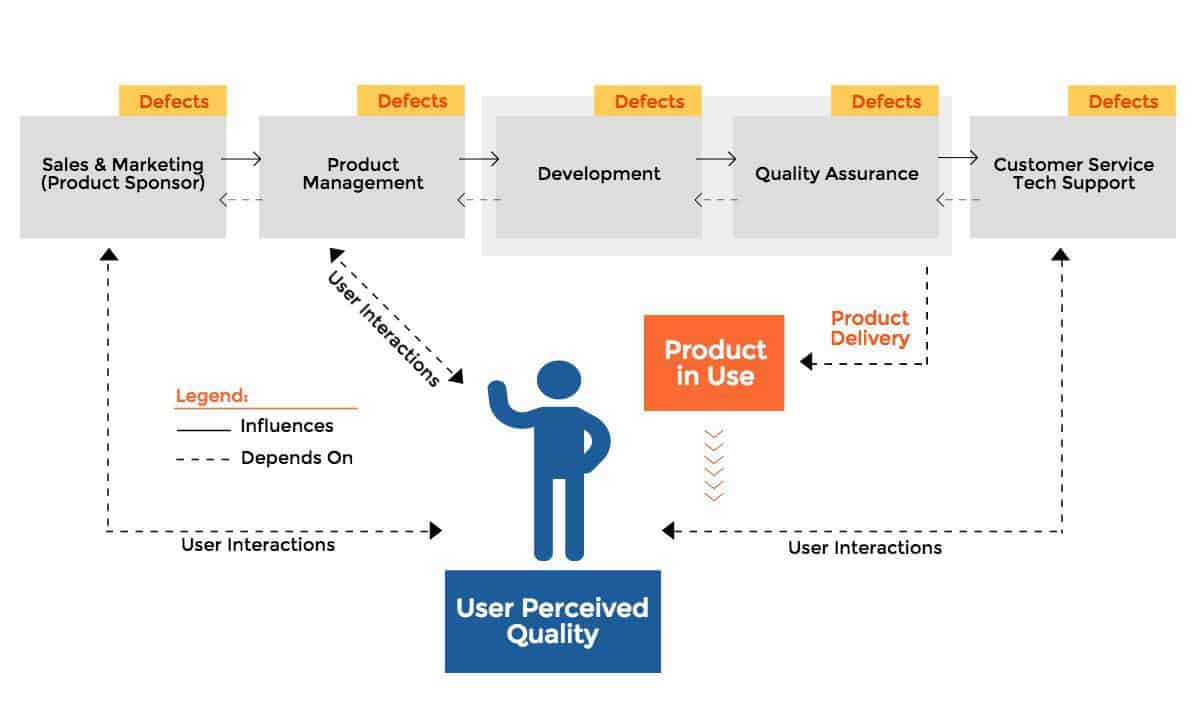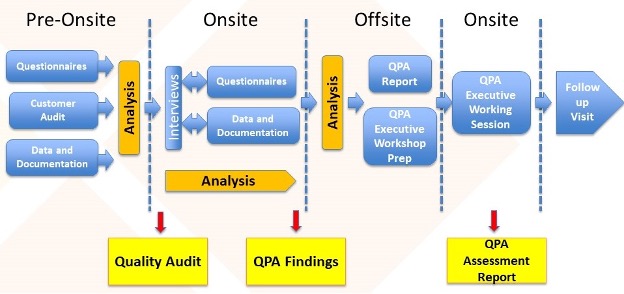Quality Process Assessment
XBOSoft’s Quality Process Assessment (QPA) examines the entire organization from the standpoint of quality – how do its people, processes, and use of technology and tools support the organization’s quality goals? Using our QPA quality assessment methodology and framework, XBOSoft works with clients to improve its quality process by uncovering the root causes of defects throughout the organization and providing a roadmap to software quality product and process improvement.
Software testing methods and processes have made significant progress over the past few years. However, testing is only one ingredient for improving software quality management. Without approaching software quality with a view of the entire product lifecycle, many opportunities for software quality improvement are overlooked. As a result, many organizations are finding that their testing strategy and software testing initiatives fall short in satisfying their quality goals. The answer lies in examining their quality processes throughout the product lifecycle and developing goals, objectives, and initiatives for each element impacting not only software quality for the product but process improvement to continually assess and improve procedures that impact the product.
The term “defect” usually applies to software defects when users operate the software and the software does not adhere to requirements or behaves in an unexpected manner. However, XBOSoft’s QPA quality assessment defines defect in a broader sense in that “defect” applies to any errors that occur from any part of the process in developing software. For example, defects can occur in marketing literature that mislead users to have incorrect perceptions of the software’s capabilities. At the end of the delivery cycle, defects can occur in customer or technical support when users call in and their concerns are not addressed correctly. As shown in the figure, defects can occur at any point in the product life cycle, not just in development. This includes defects found in the production of course, but also includes defects found in requirements that are poorly described, ambiguous, or not complete. It could also include defects in Quality Assurance such as test cases that are unclear and unable to be executed, or defects that are not reproducible. Additionally, many don’t realize the strong connection between customer service and technical support with the customer’s perception of quality and data can be used to directly influence quality assurance. By closely examining customer service and help desk tickets, XBOSoft’s QPA quality assessment can complete the cycle in determining where customers or users are directly feeling pain and what actions the organization should take earlier in the product life cycle.
Quality is the primary focus and goal, rather than just testing.
Following the review, typical benefits our clients have been able to realize include:
- Improved Quality Assurance team productivity, efficiency, and process improvement
- Improved team management and morale
- Developing and evaluating software quality improvement metrics
- Meeting group performance and business goals
- Meeting budget requirements while delivering quality products to your customers, and
- Reducing the number of calls into technical support and customer help desk
XBOSoft’s Awards and Recognitions
XBOSoft’s Quality Process Assessment
Step 1 – Pre-Onsite Data Collection – Analysis
The QPA Quality Assessment begins with a Pre-Onsite data collection period. During this time period, the client completes the pre-assessment questionnaires and collects the appropriate documentation required to kick off the study. Prior to the data collection period, we also discuss and confirm the Assessment’s objectives with the Client’s team leader for the project (typically the VP of Development, Development or Quality Assurance manager, and any other stakeholders). This phase utilizes a variety of methods for data collection:
- Questionnaires that ask the same questions phrased in different contexts and from different angles for different roles in the company to understand various viewpoints.
- Pre-Review Data Collection including various development artifacts and documentation including but not limited to test cases, defects, requirements specifications, user stories, marketing sheets, organization charts, customer service help desk tickets, quality statements, and quality process definitions.
We then analyze this information and are able to understand the different viewpoints of quality for different roles in the organization, the organization’s definition of quality, and the existing processes to achieve their quality goals.
Step 2 – Onsite Review Followed by Off-Site Analysis and Evaluation
After our analysis of the data and questionnaires, we then go onsite to work with the stakeholders for a focused period of 3-5 days gathering and analyzing supplemental data via:
- One-on-one and Small Group Interviews
- Work Observation sessions
- Data reviews
- Brainstorming Sessions during preliminary finding meetings with management
The additional information facilitates in-depth analysis of the following critical performance areas that affect Quality Assurance:
- Work Flow Process Analysis
- Management Processes and Procedures and their impact on software quality management
- Quality Assurance Engineer Job Design and organization alignment
- Quality Assurance Technology Inventory Analysis
- Defect Analysis with process improvement correlation
- Qualityware evaluation
Step 3 – The Deliverables – Assessment Report and Quality Workshop
The QPA Quality Process Assessment results in a comprehensive document that contains recommendations for immediate changes that will lead to improvements in operational procedures, workflows, technology uses, job designs, and measurements that support your quality objectives. This is followed by an executive workshop that presents the results and maps out a plan for improvement. The Assessment Report provides the following:
- A comprehensive examination of quality assurance operations
- An executive readout of findings of the current situation
- An analysis of operational-development processes from product management (requirements) to development and Quality Assurance, followed by customer service
- An analysis of defects to identify trends, correlations, and other characteristics
- A technology analysis with recommendations
- Staffing estimates based on current workload
- Work function review and recommendations
- Performance measurements analysis
- Risk analysis with recommendations for risk reduction
- Recommendations related to software quality management such as testing strategy, process improvement, and quality control.
XBOSoft has been providing professional QA consulting services for over 15 years. In the world of software QA & testing, we’ve seen a thing or two and have worked with organizations of all sizes and shapes to examine their QA processes and guide them toward long-term improvement.
We share our knowledge with the software and business community through publishing topical White Papers, presenting at conferences, and holding quality assurance workshops.
And, in the end, we assist our clients in not only improving their software quality processes but in getting the work done, providing day-in and day-out software testing services to clients globally.





